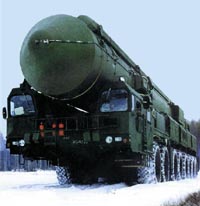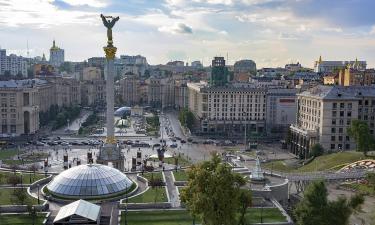Topol-M missile systems to be outfitted with multiple warheads
Russia will replace single nuclear warheads on some of its strategic missiles with multiple warheads, Russian news agencies reported Friday.

"In the near future we will begin to substitute the single warheads on Topol-M intercontinental missiles with multiple warheads," the Interfax-Military News Agency quoted Gen. Nikolai Solovtsov, commander of Russia's Strategic Rocket Forces, as saying Friday.
Fitting multiple warheads to one-warhead Topol-Ms is a cheaper way for Russia to upgrade its nuclear arsenals and maintain nuclear parity with the United States. It also makes it theoretically easier to evade missile defense systems, the AP says.
"This makes the task of replacing aging missiles much easier," said Alexander Pikayev, a Moscow-based defense analyst who is co-chair of the Committee of Scientists for Global Security.
On Thursday, President Vladimir Putin's visit to a unit of newly deployed Topol-M missiles mounted on mobile launchers. Putin called their deployment a "serious step forward in strengthening Russia's defense capability."
"It has a stronger survivability, faster launch and an ability to penetrate any prospective missile defense," Putin said.
The Topol-M missiles, capable of hitting targets more than 10,000 kilometers (6,000 miles) away, have so far been deployed only in silos. The new version, which is mounted on a heavy off road vehicle, makes it harder for an enemy to track it down.
The United States has not deployed similar mobile launch systems, but it has much more unlimited access to the sea and can concentrate its nuclear missiles in submarines, Pikayev said.
A shortage of cash following the collapse of the Soviet Union slowed the modernization of Russia's strategic arms arsenals. The military has commissioned just over 40 of the Topol-M missile since its deployment in 1997, and aging Soviet-era missiles have continued to form the backbone of the nation's nuclear capability.
In 2002, Putin and U.S. President George W. Bush signed a treaty obliging both sides to cut their strategic nuclear weapons by about two-thirds by 2012, down to 1,700 to 2,200 missiles.
When the treaty was signed, many analysts said the number of Russian nuclear weapons could fall far below the number set by the treaty.
However, the oil boom of recent years allowed the Kremlin to bolster the military budget and speed up the pace of military modernization.
Topol-M's chief designer, Yuri Solomonov, said earlier this year that Russia would easily be able to maintain at least 2,000 nuclear warheads by 2011 and beyond.
Subscribe to Pravda.Ru Telegram channel, Facebook, RSS!





